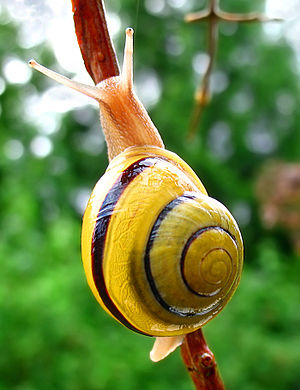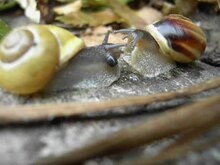Garden cepaea
| Garden cepaea | ||||||||||||
|---|---|---|---|---|---|---|---|---|---|---|---|---|

Garden cepaea ( Cepaea hortensis ) |
||||||||||||
| Systematics | ||||||||||||
|
||||||||||||
| Scientific name | ||||||||||||
| Cepaea hortensis | ||||||||||||
| ( OV Müller , 1774) |
The garden banded snail ( Cepaea hortensis ), also known as the white-mouthed banded snail or garden snail , belongs to the lung snail and can easily be confused with the closely related grove banded snail ( Cepaea nemoralis ).
features
The mouth of the garden ribbon snail is light, while the grove ribbon snail has a dark mouth. Further differences are four or more glandular appendages on the genital apparatus in C. hortensis (in C. nemoralis there are three or less) and the forked blades of the love arrow . Its shell is yellowish with variable brown or black stripes, which is why it is also commonly referred to as a snail . With a shell diameter of 25 mm, it is one of the rather small types of snail.
The garden banded snail is one of the most variable snails in terms of its color (color polymorphism ). One to five dark brown spiral bands of different widths can be found on the cases. However, some specimens in the same population have no ligaments at all.
Occurrence and way of life
The species is widespread in large parts of Western and Central Europe . It is active from March to October and does not feed on herbaceous plants, but mainly on algae , which is why it does not appear as a pest in gardens.
Often you can find housing fragments in so-called throttle forges - stones on which song throttles smash the worm housing .
The garden banded snail is an intermediate host for the badger lungworm Aelurostrongylus falciformis .
literature
- Rosina Fechter, Gerhard Falkner : Steinbach's natural guide. Volume 10: Mollusks. Mosaik-Verlag, Munich 1990, ISBN 3-570-03414-3 .
Web links
- Different variations of the case pattern
- Cepaea hortensis inthe IUCN 2013 Red List of Threatened Species . Posted by: Neubert, E., 2011. Retrieved February 13, 2014.
Individual evidence
- ↑ Schnirkelschnecken (Helicidae) at www.weichtiere.at
- ^ Roy C. Anderson: Nematode Parasites of Vertebrates: Their Development and Transmission . CABI, 2000, ISBN 978-0-85199-786-5 , pp. 164 .


